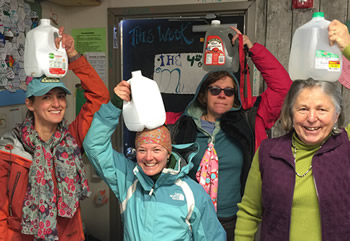News and Highlights
This is a list of past iUTAH EPSCoR news from 2012 to 2018.
May 3, 2017
Climate Change Book Initiates Discussion
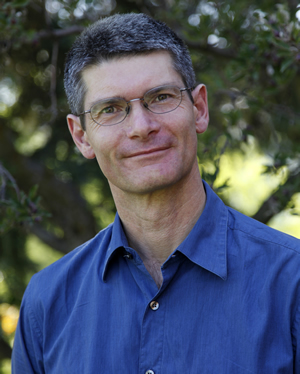
iUTAH researcher Dan Bedford was featured in a recent news story titled “Weber State professors respond to climate misinformation spun by recent book.” The article appeared in the April 24 edition of the Standard Examiner. Bedford was one of three faculty members asked to respond to a book questioning the scientific consensus on climate change. Here’s a short excerpt below:
“The book, titled “Why Scientists Disagree About Global Warming,” was published by the Heartland Institute. It claims what its title suggests, despite the fact that 90 to 100 percent of climate scientists agree climate change is real, human-caused and warming the planet at an alarming rate. The Heartland Institute is a nonprofit think tank with funding ties to fossil fuel industries…. The book attempts to debunk studies finding consensus among scientists about human-caused climate change and discredit findings by the Intergovernmental Panel on Climate Change, or IPCC.
Dan Bedford, a geography professor at Weber State, also received a copy of the Heartland Institute book. ‘My reaction to seeing this book is rather mixed,’ he said. ‘On the one hand, the whole idea of disseminating misinformation on a large scale about any scientific topic … that’s fundamentally problematic. I was upset about that.’ ”
May 2, 2017
Presentation on GAMUT at Water Commission Meeting
iUTAH data manager Amber Jones gave a presentation at the biannual Bear River Commission Water Quality Committee meeting held in Salt Lake City on April 10. In attendance were leadership and personnel from water quality agencies in Utah, Idaho and Wyoming, including state and federal offices, private interest groups, and public utilities, focused on the Bear River Basin. The committee was interested in learning about iUTAH’s water quality monitoring and research.
The iUTAH project was invited to the meeting because of the committee’s interest in the water quality data collected as part of the ‘Gradients Along Mountain to Urban Transitions’ GAMUT network. Jones discussed GAMUT and the tools, infrastructure, and processes used for data management and quality control. Participants included “scientists, regulators, and interested citizens interested in exchanging information and expertise,” said Jones. “It was an excellent opportunity to interact with water quality professionals and interested parties and to apprise state agencies about the work being done as part of iUTAH. “
Bear River Commission Water Quality Committee meets twice annually as part of its efforts to inform and educate its members on technical and policy expertise regionally in connection with water quality. They also host the Bear River Watershed Information System website.
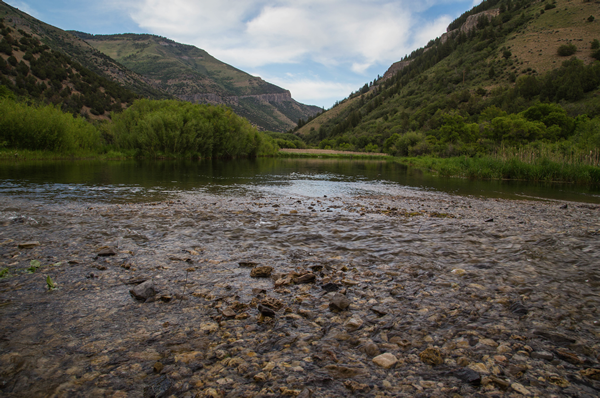
April 25, 2017
Mystery of the Missing Mercury at the Great Salt Lake

Westminster College and iUTAH researcher Frank Black has been in the news for his contributions to research on the changes in the toxic methylmercury levels in deep waters of Utah’s Great Salt Lake, between 2010 and 2015. The story, conducted in collaboration with a team of 10 scientists from the University of Utah, Westminster College, and Utah Department of Natural Resources, came out in a paper published April 12 in Environmental Science & Technology.
A media release provided by the University of Utah’s science writer Paul Gabrielsen said the “disappearance of the mercury was not due to aggressive environmental policies or a wide-ranging cleanup effort. Instead, it’s part of a story involving a large-scale unplanned chemistry experiment, a sometimes-stinky lake, and ducks – in which the mercury did not disappear…. A Union Pacific railway line crosses the lake, dividing it into a smaller north arm and a larger south arm, with the line drawn right at the base of the bunny-ear-like northern extensions of the lake. Because the north arm has no major river inflow, it’s much saltier than the south arm. Two culverts in the railroad line allowed briny north arm water to flow into the south arm and, because of its higher density, sink to the bottom of the south arm.”
“The difference in density between the deep and shallow waters prevented mixing, says (University of Utah) geology and geophysics professor William Johnson, and kept fresh oxygen from infiltrating into the deeper water layers. Decaying organic matter on the lake floor sucked all the oxygen out of the briny layer, forcing microorganisms to find something else to “breathe.” Without oxygen, some bacteria turn to nitrate to fuel the chemical processes of life. When the nitrate is gone, they turn to iron, manganese, and finally sulfate. Residents of the Salt Lake Valley may have noticed a byproduct of the sulfate-breathing bacteria – sulfide, a stinky rotten egg smell emanating from the lake. In another side effect, the bacteria turn elemental mercury into toxic methylmercury.”
Research on this study was funded by iUTAH through two Research Catalyst Grants in 2014 and 2017. Black’s current funding award builds upon his earlier work on the Great Salt Lake by examining wildfire ash and GSL dust as sources of heavy metals to Utah’s aquatic ecosystems. RCG funding supports a collaborative culture of multi-institutional research, encouraging primarily undergraduate institutions such as Westminster College, to involve themselves and their students in current science research. Chris Mansfield, a recent graduate of Westminster College and one of Black’s students, was involved in the team that published the study.
The study can be found in its entirety here.
Press: UNews | Phys.org | Science Newsline | ScienceAlert

April 24, 2017
Former iFellow Kari Norman receives prestigious NSF fellowship
Kari Norman was one of eight Utah State University scholars selected for a 2017 National Science Foundation Graduate Research Fellowship. In 2013, Norman participated in iUTAH’s iFellows program, which places undergraduate students in the laboratories of iUTAH project scientists to gain first-hand research experience. She worked directly with iUTAH mentor Sarah Null, of USU, during her 11-week with the program.
While at USU, Norman also worked on biodiversity maps of bird species in North America with the Undergraduate Research Fellow program in USU’s Office of Research and Graduate Studies. She said of her experience working on the biodiversity data that maps “inform both research and governmental organizations about where the most important areas are to conserve. We want to conserve the areas with the highest number of species.”
Norman, a 2016 graduate in mathematics, statistics and wildland resources, studied the effects of climate change on Uinta ground squirrels with USU Wildland Resources faculty mentor Lise Aubry. She is currently a doctoral student at University of California, Berkeley in the Environmental Science, Policy and Management department, and is interested in how people make conservation decisions; specifically the metrics used to determine places most important to conserve and how those metrics change over space and time.
Press: Utah State Today | Deseret News
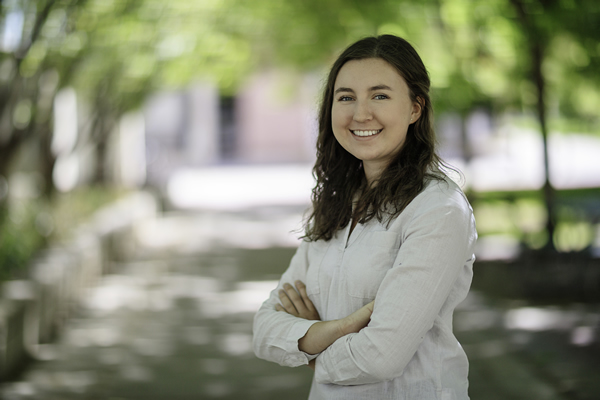
April 24, 2017
Student Reports on Water for UPR Radio
Julie Kelso, Utah State University PhD candidate and iUTAH Graduate Research Assistant, can be found on the airwaves these days, talking science and specifically water issues with area experts. Kelso is one of two students who received an internship, funded by USU’s Ecology Center to gain hands-on experience in science communications by working with Utah Public Radio. As a researcher, Kelso studies the effects of human development on nutrient and carbon cycling in rivers of northeast Utah with faculty mentor Michelle Baker. She has been working with the iUTAH project for over four years, helping to further research and understanding of Utah’s water systems physically, biologically, and as a social system. Kelso says that she “got started in radio because I wanted to get a better idea of how science in translated to the general public.”
“I also wanted to experience immediate feedback from the public on scientific stories,” said Kelso. “That is what I like most about science journalism. Also, I get to talk to all kinds of people about all kinds of science and natural resources management decisions.”
Kelso’s first story as a science reporter for UPR involved interviewing Brian McInerny from the National Weather Service about snow hydrology and predicting spring runoff from melting snow. She has also produced stories on spring flooding in northern Utah and iUTAH researcher Jeff Horsburgh’s metering and water conservation efforts in Utah. She also plans to explore Rocky Mountain Power’s plans for alterations to the Bear River. This series is an excellent example of science communications in action and engagement of the general public in the water-related science happening around the state. We look forward to hearing more stories from Julie in the future as she continues to produce science stories on UPR for Utah listeners.
Press: Utah Public Radio: Snow Hydrology | Flooding in Northern Utah | Water Data and Conservation


April 14, 2017
iUTAH Donates 235 Water Books to Area Libraries
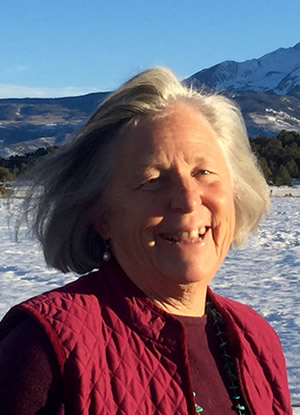
Each year in early May, Utah dedicates a week to public awareness and involvement in water issues, both locally and globally. This year, iUTAH is partnering with the Intermountain Section of the American Water Works Association (IMS-AWWA) in celebration of 2017 Utah Water Week (UWW) on May 7-13. Among the events and activities taking place, UWW brings water-related books, and occasionally their authors, to local libraries and schools across the state. This year, the award-winning Water Runs Through This Book is one of two UWW Library Books that have been chosen to educate people on the importance and scarcity of water. The production of Water Runs Through This Book by Nancy Bo Flood was supported by iUTAH to strengthen and promote an inclusive, diverse, water-wise community in Utah. Copies of the book are being donated to 210 libraries in Utah, and 25 libraries in southern Idaho.
Ellen Eiriksson, iUTAH Education, Outreach and Diversity Coordinator, said “iUTAH is thrilled to bring author Nancy Bo Flood back to Utah to help celebrate Utah Water Week and to be partnering with a variety of community, institutional, and education partners across the state, to share the book's view of water.” A partial list of the libraries and schools Bo Flood will visit throughout Utah include:
- Emery and Grand County, UT– May 2 - 5
- Weber County Libraries – May 9 - 10
- North Logan Library, North Logan UT– May 10, 7 p.m.
- Edith Bowen Laboratory School – May 11
- Logan Library, Logan UT– May 12, 3 p.m.
“This book captures the spirit of our connection to water, while also addressing and celebrating the different ways people worldwide interact with this resource,” said Eiriksson. “Nancy will be bringing this discussion to audiences state-wide, asking people to reflect on and celebrate their connection to water, while also examining on how we can be better stewards of it.” Bo Flood will also speak at the Water Education Awards Banquet honoring the winners of the Utah Division of Water Resources Young Artists Poster Contest, an event attended by 4th grade students from around the state, and their families, and teachers.
"I have been a professional in environmental education since 1972 and have seen many water education books,” said Barbara Middleton, Friends of the North Logan Library board member. “What I like about this book is the international focus, the images and the succinct clarity of how water runs through our lives."
iUTAH’s partner, Utah Water Watch, will present various citizen science opportunities for water quality monitoring throughout the state during Water Week. Please check out the 2017 Utah Water Week website for a complete list of activities and events.

